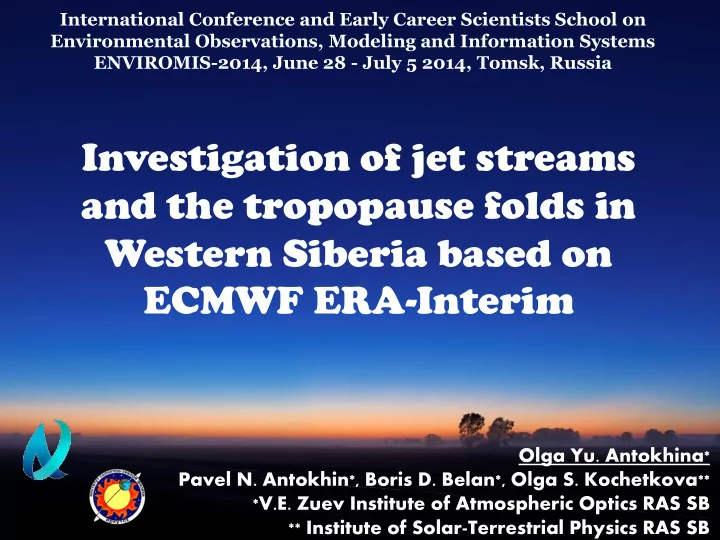

International Conference and Early Career Scientists School on Environmental Observations, Modeling and Information Systems ENVIROMIS-2014, June 28 - July 5 2014, Tomsk, Russia Investigation of jet streams and the tropopause folds in Western Siberia based on ECMWF ERA-Interim Olga Yu. Antokhina* Pavel N. Antokhin*, Boris D. Belan*, Olga S. Kochetkova** *V.E. Zuev Institute of Atmospheric Optics RAS SB ** Institute of Solar-Terrestrial Physics RAS SB
Background study 1. One source of ozone in the troposphere is stratospheric ozone (pic. 1). 2. Although photochemistry in the lower troposphere is the major source of tropospheric ozone, the stratosphere – troposphere transport of ozone is important to the overall climatology, budget and long- term trends of tropospheric ozone. Pic. 1. Sources of tropospheric ozone 3. Dominant and most effective form of stratosphere-troposphere exchange (STE) in the extratropical latitudes is the intrusion of ozone into the lower layer in the tropopause folds (TF). TF mainly formed in baroclinic zones of subtropical and polar jet streams (SJ and PJ). 4. Purpose of our study: analysis of TF events for one year based on the potential vorticity data; identification of relationship between the TF and jet streams in 2 Western Siberia.
Dynamical tropopause. Potential vorticity (PV). PV – Relationship between the relative vorticity, Coriolis parameter, gravity, gradient of potential temperature in pressure coordinates. Transport only occurs along lines of constant potential vorticity unless you have diabatic heating or turbulent mixing. Thus potential vorticity is a good tracer for stratospheric air masses and tropopause folding events. P= (𝜊 𝜄 + 𝑔) − ∂θ ∂p =Const 𝟐𝐐𝐖𝐕 – upper boundary tropospheric air, Tropospheric air subject to stratospheric influence; 2 𝐐𝐖𝐕 − ozonepause 3-4 𝐐𝐖𝐕 − termopause 3
Stratospheric and Tropospheric Air. TF formation. • Stratospheric Air: – high ozone concentration which is good for protecting life from harmful radiation of the Sun – high values of potential vorticity (greater than 1) Tropospheric Air: • – low ozone concentration which is good for plants or animals – low values of potential vorticity (less than 1) Pic. 2. Scheme of TF formation • Conditions of the formation and main features of TF are: – Deep minimum of tropopause height in the form of streamers or whirlpool elongated along atmospheric front (descending branch of the circulation cell). – Tropopause bulge on the warm side of the high frontal zone (HFZ) (ascending branch of the circulation cell). – d eep penetration of cold air mass to south and formation of high-altitude 4 trough with a closed center baric circulation.
Methods and Data • Time-altitude cross section to select events TF ( potential vorticity from 1 to 4 PVU) . from 1000 hPa to 1 hPa, for 0, 6, 12 and 18 hours GMT, on 1 January to 31 December 2012. Point: fixed longitude 85E, latitude from 50N to 85N. • Latitude-altitude cross section to study selected events ( potential vorticity from 1 to 4 PVU, horizontal component of velocity field>20 m/s) . from 1000 hPa to 1 hPa, 85N from 0N to 90N. • Synoptic map AT500 for analysis HFZ. Potential vorticity and horizontal component of velocity field based on ECMWF ERA-Interim 5
Result Seasonal variability Seasonal variation of tropopause height and the amounts of events TF depend on the latitude. In the latitudinal belt from 50N to 65N there is a distinct seasonal variability (winter-summer) of the dynamic tropopause height. Maximum amount of TF events observed here in the winter-spring period. Above 70N there is no clear seasonal variation of tropopause height. Maximum amount of TF is shifted to spring-summer time. Fig. 4. Seasonal variability of potential vorticity (PVU) at points 55N-85E and 75N-85E. (bright blue line – 1PVU) 6
Deep of intrusion. Connection with jet stream. A B SJ PJ C TF Pic. 6: (A) Latitude-altitude cross-section of potential vorticity (isolines 1-4 PVU) and horizontal component wind field (fill). (B) Jet stream (300 hPa). (C) Synoptic maps 7 AT500 Data 9 may 2012
21 April 2012 B A SJ PJ C TF Pic. 7: (A) Latitude-altitude cross-section of potential vorticity (isolines 1-4 PVU) and horizontal component wind field (fill). (B) Jet stream (300 hPa). (C) Synoptic maps 8 AT500
25 February 2012 B A PJ-? SJ C TF Pic. 8: (A) Latitude-altitude cross-section of potential vorticity (isolines 1-4 PVU) and horizontal component wind field (fill). (B) Jet stream (300 hPa). (C) Synoptic maps 9 AT500
12 December 2012 B A PJ C SJ TF Pic. 9: (A) Latitude-altitude cross-section of potential vorticity (isolines 1-4 PVU) and horizontal component wind field (fill). (B) Jet stream (300 hPa). (C) Synoptic maps 10 AT500
11 July 2012 A B SJ PJ C TF Pic. 5: (A) Latitude-altitude cross-section of potential vorticity (isolines 1-4 PVU) and horizontal component wind field (fill). (B) Jet stream (300 hPa). (C) Synoptic maps 11 11 AT500.
Spatial scale SJ PJ TF Pic. 10. TF events. 22.02.10 Cross-section 90E. Latitude from 52N to 60N longitude from 85E to 95E 12
Conclusion 1. In general there is good agreement between the characteristics of the studied TF events and characteristics of TF events obtained by other authors. 2. On the investigated longitude TF events were associated with the subtropical jet stream to the latitude 50N and with the polar jet at higher latitudes. At 50N often there was a convergence of jets. 3. Amounts of TF events varies in different seasons on the different latitudes. In the latitude band 50-65N TF events repeated more often in the winter-spring period, in the band 65-85N – in the spring-summer period. These features are probably related to relief and seasonal HFZ movement in the study region. 4. For a detailed analysis of the depth of the intrusion in the JS area is necessary to consider a deviation from the meridional direction of trough axis.
Thank you for your attention!
Elevation profile Pic. 3. Elevation profile in the area 85E Google Earth maps 15 15
Recommend
More recommend